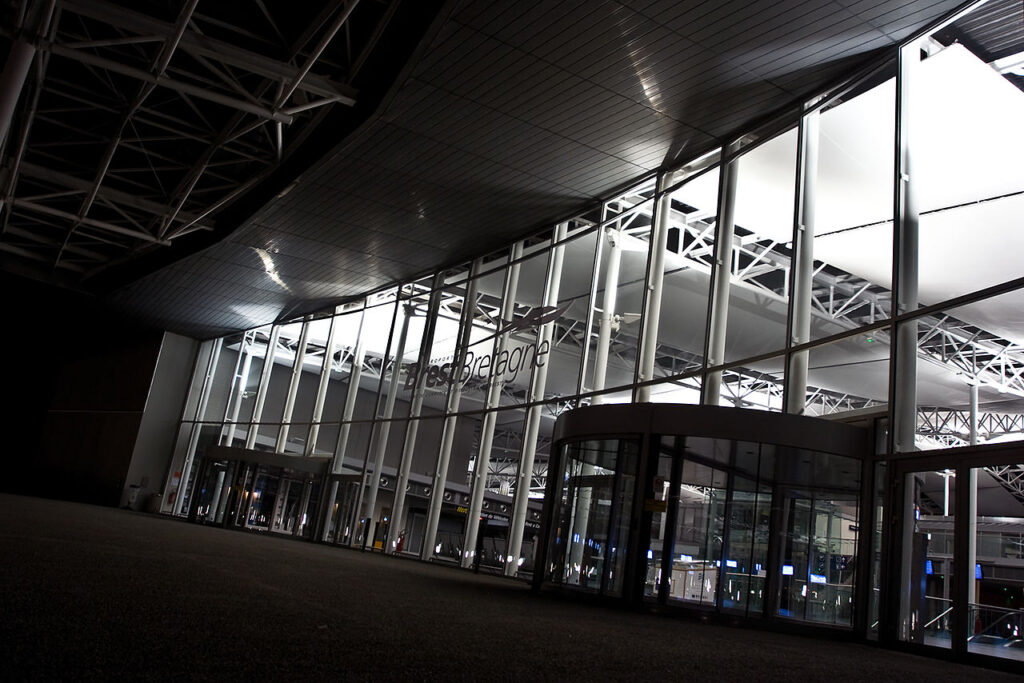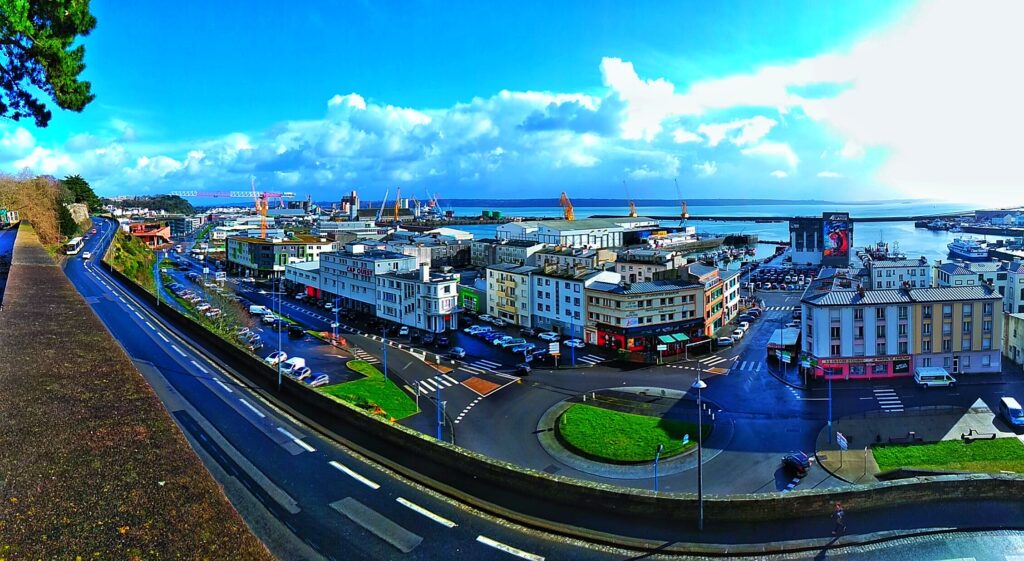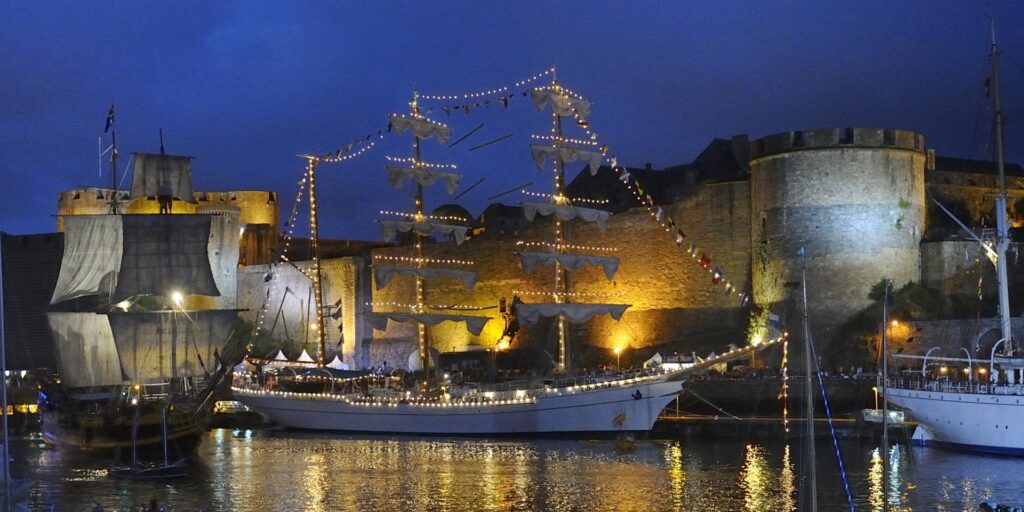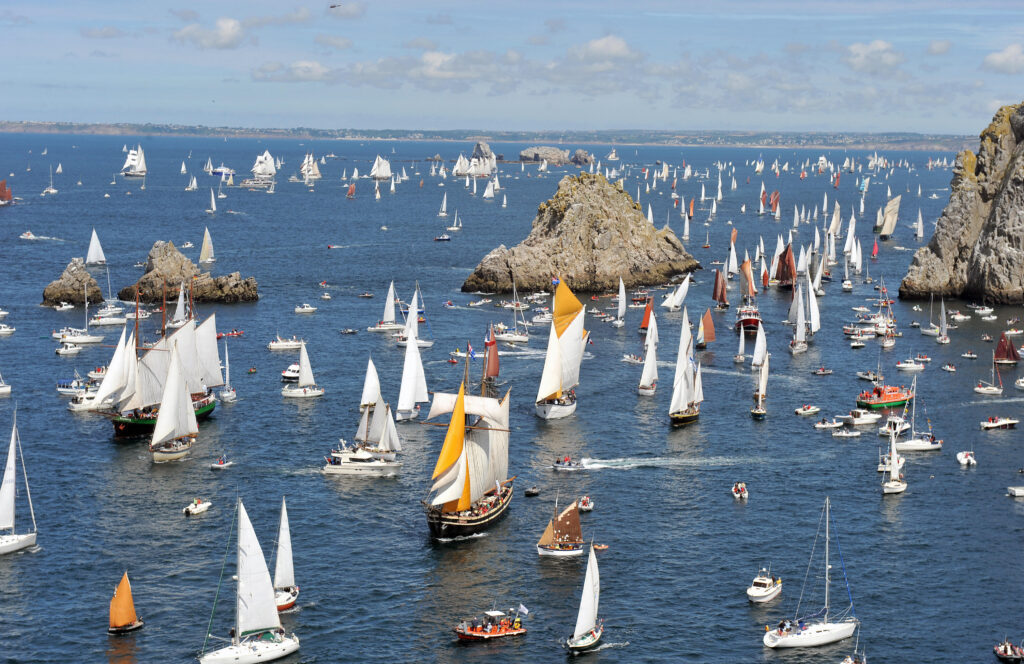Brest is a port city in the Finistère département in Brittany. Brest is an important harbour and the second French military port after Toulon. The city is located on the western edge of continental Europe.
| Country | France |
|---|---|
| Region | Brittany |
| Department | Finistère |
| Mayor (2020–2026) | François Cuillandre |
| Area | 49.51 km2 (19.12 sq mi) |
| Population (2017-01-01) | 140,064 |
| Density | 2,800/km2 (7,300/sq mi) |
| Time zone | UTC+01:00 (CET) |
| Summer (DST) | UTC+02:00 (CEST) |
Nowadays, Brest is an important university town with 23,000 students. Besides a multidisciplinary university, the University of Western Brittany, Brest and its surrounding area possess several prestigious French elite schools such as École Navale (the French Naval Academy), Télécom Bretagne and the Superior National School of Advanced Techniques of Brittany (ENSTA Bretagne, formerly ENSIETA).
Coat of arms
The meaning of the coat of arms of Brest is half France (the three fleurs-de-lis of the former kingdom of France), half Brittany (semé d’hermine of Brittany).
Sights
Pont de Recouvrance (Recouvrance Bridge, is a massive drawbridge 64 m/210 ft high), the military arsenal and the rue de Siam (Siam Street) are other sights. The castle and the Tanguy tower are the oldest monuments of Brest.
The Musée de la Tour Tanguy, in the Tanguy tower, houses a collection of dioramas that depict the city of Brest on the eve of World War II. The Musée national de la Marine de Brest, housed in the ancient castle, contains exhibits which outline Brest’s maritime tradition, as well as an aquarium, the Océanopolis marine centre.
The city also has a notable botanical garden specializing in endangered species, the Conservatoire botanique national de Brest, as well as the Jardin botanique de l’Hôpital d’Instruction des Armées Clermont-Tonnerre.
A few kilometres out of town, there are landscapes, from sandy beaches to grottos to tall granite cliffs. Sunbathing, windsurfing, yachting and fishing are enjoyed in the area.
- The Tanguy tower hosts a museum of the history of Brest
- The castle hosts the Musée national de la Marine
- the conservatoire botanique national in autumn
- Saint-Sauveur church in Recouvrance
Geography
Brest is located amidst a dramatic landscape near the entrance of the natural rade de Brest (Brest roadstead), at the west end of Brittany.
It is situated to the north of a magnificent landlocked bay, and occupies the slopes of two hills divided by the river Penfeld. The part of the town on the left bank is regarded as Brest proper, while the part on the right is known as Recouvrance. The hillsides are in some places so steep that the ascent from the lower to the upper town has to be effected by flights of steps and the second or third storey of one house is often on a level with the ground storey of the next.
Transport
The railway station of Brest, Gare de Brest, is linked to Rennes and Paris and provides services to other stations in Brittany as well. TGV trains to Paris take approximately three hours and forty minutes to reach the capital.
Brest international airport, Brest Bretagne Airport, is mainly linked to Paris, London, Nice, Lyon, Dublin.
The harbour of Brest is mainly dedicated to bulk, hydrocarbon and freight containers.
Economy
Due to its location, Brest is regarded as the first French port that can be accessed from the Americas. Shipping is big business. The protected location of Brest means that its harbour is ideal to receive any type of ship, from the smallest dinghy to the biggest aircraft carrier.
Despite its image of an industrialised city whose activity depends mainly on military order, the service sector represents 75% of the economic activity. Brest also hosts headquarters for many subsidiaries like the banking group Arkéa. Research and conception is taking an increasing importance. Brest claims to be the largest European centre for sciences and techniques linked to the sea: 60% of the French research in the maritime field is based in Brest.
Breton language
Like other French minority languages, Breton does not have any official language status in France.
The municipality launched a linguistic plan to revive Breton as a language through Ya d’ar brezhoneg on 16 June 2006. Besides bilingual schools, the Breton language is also taught in some schools and universities.
Culture
The city is host to several events to celebrate its long maritime history. The largest of these is held every four years, when the town organises a tall ship meeting.
Brest also hosts an annual short film festival called “Brest European Short Film Festival”.
Cuisine
Brittany’s most famous local delicacy, the Breton crêpe, is the main culinary feature apart from seafood. There are many crêpe restaurants (called crêperies). Breton apple cider is often featured.
Traditional biscuits include Traou Mad, which is a full-fat butter biscuit similar to Scottish shortbread.
Sport
Brest has held the Grands Départs of the Tour de France on three occasions, in 1952, 1974 and 2008.
Brest is home to Stade Brestois 29, a football team in Ligue 1. the top tier of the French football league system,
Brest is also home to Brest Albatros Hockey.
Research and education
Primarily the research centre of western Brittany, Brest and its surrounding area is the home of several research and elite educational establishments:
- a multidisciplinary university, Université de Bretagne Occidentale (UBO)
- Brest has also several grandes écoles and other undergraduate or graduate schools:
- École nationale d’ingénieurs de Brest (ENIB)
- Télécom Bretagne (ENST Bretagne)
- Brest has several research organisations:
- the largest Ifremer (French Research Institute for Exploitation of the Sea)
- Le Cedre (Centre of Documentation, Research and Experimentation on Accidental Water Pollution)
- the French Polar Institute
- The Naval Hydrographic and Oceanographic Service (SHOM)








